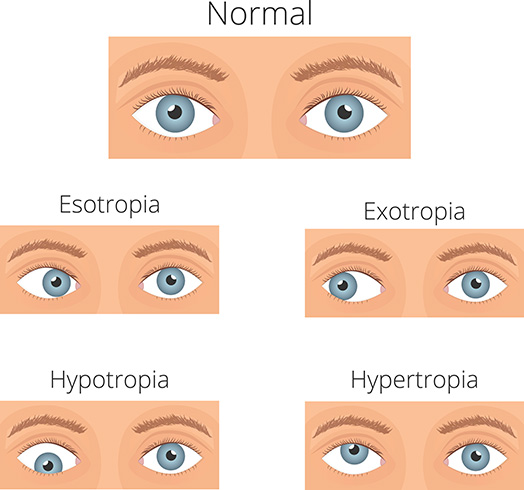"*" indicates required fields

22/07/2021

Types of strabismus (Source: iStock)
To move your eyes, your brain sends a signal through various cranial nerves to your eye muscles. Each muscle then contracts or relaxes, depending on the direction your eyes need to move. Your eyes should move together at the same time, in the same direction.
In patients with strabismus, eye alignment is affected. The eyes do not point in the same direction and/or might not move together. One or both eyes may point inwards, appearing ‘crossed’ (known as esotropia), outwards (exotropia), upwards (hypertropia), or downwards (hypotropia). The misalignment may come and go or be permanently present.
Strabismus is commonly known as ‘squint’, ‘turned eyes’ or ‘crossed eyes’. It can affect children and adults.
Strabismus treatment (cross eye treatment) focuses on improving eye alignment.
Since the eyes point in two different directions, each eye sees a different image. The symptoms the patient experiences will vary depending on how their brain processes the two images and may include:
*Amblyopia is also known as ‘lazy eye’ and can result in poor vision in the affected eye.
These visual difficulties can make day-to-day activities more challenging. Additionally, the cosmetic appearance of the condition, and/or the inability to make eye contact during social interactions, can lead to problems with self-esteem and building social connections.
While the exact cause of strabismus is unknown, most cases are probably due to an inability of the visual area of the brain to align the eyes correctly. Less commonly, one or more of the eye muscles may not be functioning properly. Sometimes, strabismus may occur due to weakness or paralysis of the cranial nerves controlling the eye muscles.
Strabismus may also occur due to another medical condition.
Yes – strabismus treatment (cross eye treatment) includes glasses, prisms, botox, eye exercises (occasionally) and strabismus surgery (also called squint eye surgery). The goal is to improve eye alignment, allowing them to work together better (‘binocular vision’).
Strabismus treatment should be initiated as early as possible to improve outcomes, especially in young children. Children who are treated before they are six years old tend to have better long-term visual outcomes.
It is important to note that, although strabismus may get better or worse at times, it very rarely resolves on its own. However, in extremely rare cases, infants under four months old may spontaneously recover.
For more information about the surgical treatment of strabismus, read our Strabismus surgery fact sheet.
The information on this page is general in nature. All medical and surgical procedures have potential benefits and risks. Consult your ophthalmologist for specific medical advice.
Date last reviewed: 2023-03-31 | Date for next review: 2025-03-31